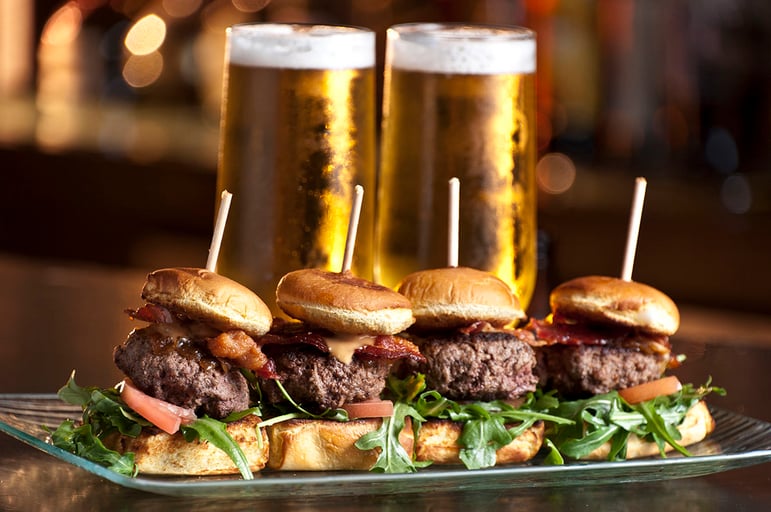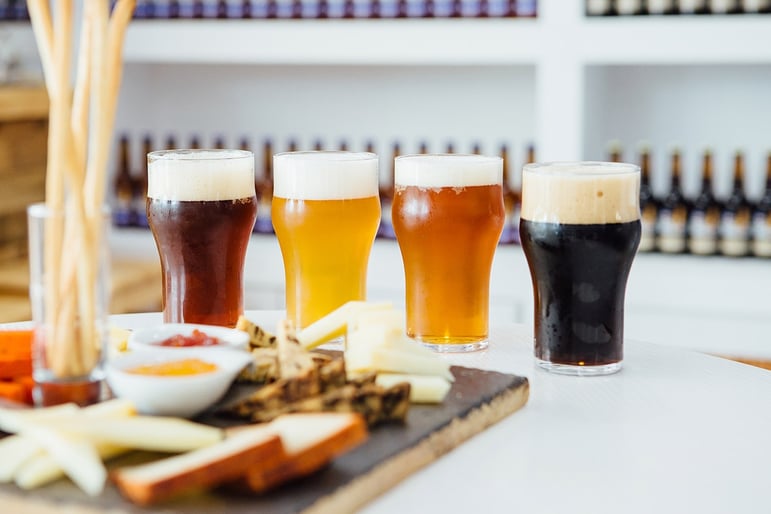For those of you who have a restaurant or food service facility with a bar, getting a handle on beer serving is an essential investment. Not only will it set your level of quality apart from the competition, but it will also help increase your bar profits and open up new horizons.

However, before setting off on a beer education, food service professionals should know that there is a lot more that goes into crafting a beer than throwing water and barley into a keg. In fact, to fully appreciate different beer styles, their flavors and their best food pairings, it is important to understand the brewing process and terminology.
To help you jump into the world of beer and food pairing, here is a list of beer and brewing terms:
ABV: Alcohol by Volume
ABV varies throughout the different craft beer styles, ranging from about 3% ABV to more than 20%. In beer styles with higher ABV percentages, the flavor of alcohol may be intentionally more prevalent, and the effect of alcohol will hit a customer faster.
Ale: Ales are beer styles fermented at a higher temperature (60°-75°F) with top-fermenting yeast. Because of the higher temperature, this fermentation process is quicker than that of a lager, and ales are also generally served closer to room temperatures. Additionally, ale yeast often has by-products known as esters that have fruity or flowery aromas, often making them excellent dessert beers. Examples of ale styles:
- Hefeweizens
- Any IPA
- Lambics
- Rye Beers
- Stouts
- Witbiers
Aroma: The scent of the beer once it is poured into its proper glass. A glass should always match the beer style to promote the right amount of foam and carbonation, resulting in the intended aroma and flavor. The scent comes from a variety of different sources, including alcohol, hops, malt, esters, phenol and more.
Barley: A cereal grain commonly made into malt and used as a base to brew beer and distill certain spirits. The grain is harvested from Hordeum vulgare, grass grown in temperate climates around the world.
Body: According to CraftBeer.com, it is the consistency, thickness and mouth-filling property of a beer. Palate fullness in the mouth ranges from thin-bodied (like a , a lighter German lager) to full-bodied (like a , a strong German lager).
Boiling: The point in the brewing process in which wort (see below) is created with malt and hops. Boiling is a crucial step, as it removes unwanted compounds like dimethyl sulfide and the coagulation of unwanted proteins from the brew. Boiling also sterilizes a beer and ends the conversion of proteins to sugars. When it comes to building a recipe, this is the step where a brewer might add extra hops to create a stronger bitterness, or hoppy flavor, and aroma to the beer.
Clarity: Also known as turbidity, clarity refers to your ability to see through a beer, giving clues to the yeast content or quality. Some beer styles, like a hefeweizen (meaning yeast beer), are made to look cloudy. Others should be served crystal clear. In general, there are four types of judged beer clarity: brilliant, clear, slight haze, and hazy.
Esters: Common in ale styles of beer, esters are the fruity or flowery flavors and aromas produced by mixing organic acids and alcohol in the fermentation process.
Fermentation: The process in which yeast metabolizes the sugar-filled wort solution to produce alcohol and carbon dioxide. There are two methods of fermentation in brewing: top fermentation, produced using ale yeast, and bottom fermentation, using lager yeast.
Hops: The cone-like strobiles (or flowers) of a perennial climbing vine, also known as Humulus lupulus. While there are male and female hop plants, the ripened, unfertilized female plants are the ones used to flavor beer and stop bacterial growth in the wort. There are currently over a hundred varieties of hops growing around the world, which contribute to the bitterness, zest, and citric flavors in beer styles.
IBU: International Bitterness Units
Beer bitterness is subjective. However, in an attempt to create a more objective measurement, IBU gauges a beer's level of bitter taste based on its hop content. This unit ranges from 0 to over 100. Even so, a number of other factors can affect a beer's perceived bitterness, such as cooler serving temperatures, carbonation, and sugar content.
Lager: Lagers are beer batches that are fermented using bottom-fermenting yeast. This process takes a lot longer than the ale process due to the cold fermentation temperature (34°-55°F). Many lagers are stored for an additional period to allow the beer to mature and the flavors to enhance. Lager yeast does not produce as many by-products as ale yeast, like esters, allowing crisp flavors to take the spotlight. Examples of lager styles:
- Bocks
- Doppelbocks
- Oktoberfest Beers
- Pilsners
Malt: Barley cereal grains that have been germinated by soaking in water and then dried in kilns to stop the germination process.
Mashing: After germination, hot water is then added to the resulting malt starch to convert it to a more soluble sugar solution called wort. The non-soluble carbohydrates included in the malt starch will add body and other characteristics to the final beer. The process takes several hours.
Phenols: A type of chemical compound that is often present (at least to a degree) in beer. Certain beer styles purposefully include phenolic flavors and aromas, such as German wheat beers or smoke beers. On the other hand, unintentional phenols convey a clove-like, medicinal, or herbal aroma or flavor and are the result of the water used in the brewing process, a bacterial infection in the wort or yeast, and chemicals that have made their way in through cleaning processes or can linings.

Residual Sugar: The sugar leftover after fermentation that the yeast did not consume. Beer left with a lot of residual sugar will usually taste sweet (or malty as some like to put it) and have a fuller body. On the other hand, a beer with less residual sugar will be less full-bodied and will not taste as sweet.
SRM: Standard Reference Method
Refers to the system used by brewers to label a finished beer's color. The range in color goes from 1.0, meaning a beer is very pale or straw-like, to 40, where you will find the black stouts. Here is an estimate of the SRM levels and their associated colors:
- 1.0 - 2.0 SRM: Straw
- 2.0 - 4.0 SRM: Yellow
- 4.0 - 8.0 SRM: Gold
- 8.0 - 10.0 SRM: Amber
- 10.0 - 12.0 SRM: Copper
- 12.0 - 15.0 SRM: Red/Light Brown
- 15.0 - 20.0 SRM: Brown
- 20.0 - 30.0 SRM: Dark Brown
- 30.0 - 40.0 SRM: Black
Wheat: Similar to Hordeum vulgare, the grass harvested for barley, wheat is a grass grown for its cereal grain. While most commonly used in baking, it is also used to brew wheat beers like the Belgian-style witbier. For those with celiac’s disease or a gluten intolerance, wheat and barley can be substituted in the brewing process for gluten-free ingredients like rice, buckwheat, or millet to name a few.
Wort: The bittersweet, malty liquid made in the mashing process from malt and hops. Wort is the solution that becomes beer through fermentation.
Yeast: Possibly the most important ingredient in beer. Yeast is used during the fermentation process to convert the natural malt sugars in wort into alcohol and carbon dioxide, resulting in the carbonated, flavorful, refreshing beer styles we know and love.
Thanks to our Sources:
Beer Advocate
CraftBeer.com
.jpg?width=192&name=BLT_Only_Logo_Black%20(19).jpg)


